HAZELNUT SEEDLINGS or
HAZELNUT FRUIT TREE PLANT
Hazelnut seedlings, facts:
Hazelnut seedlings are demanded today more than ever. More and more people are interested in planting hazelnuts.
Hazelnut is a deciduous tree. It originates in the temperate regions of North America, Europe and Asia. Wild hazelnut grows on well-drained soils, in areas that provide sufficient moisture. Hazelnut cultivation began more than 5,000 years ago, when humans discovered the nutritional and health benefits of this plant. Hazelnuts are still very popular and one of the most cultivated and consumed species in the world.
Hazelnut seedlings are high-priced today!
- Hazelnut is a small tree that typically grows 20 to 40 feet tall.
- Hazelnut seedlings have green, rounded leaves that are double toothed at the edges. Both sides of the leaves are covered with fine hairs.
- Hazelnut is a monocose plant, which means that single male and female flowers develop on the same tree. The male flowers are yellow. The female flowers are small and red in color.
- The hazelnut seedlings are pollinated by the wind. The wind carries pollen to the female flowers during winter. Pollen remains dormant for 7 to 8 months (until May or June), when the fruit begins to develop.
- Hazelnut fruit is a nut covered with a leafy capsule. Hazelnuts are produced in clusters. A firm outer shell protects the fruit, a yellowish-brown core hidden inside.
- Hazelnut harvesting usually takes place from September to October. Ripen hazelnuts fall to the ground. They can be collected manually or with the help of a specially designed machine called a sweeper that works as a vacuum cleaner.
- Hazelnuts are a rich source of mono-unsaturated fatty acids, dietary fiber, vitamins A, E and folic acid (B9) and minerals such as manganese, magnesium, phosphorus and iron.
- Hazelnuts can be consumed as raw or as an ingredient in many sweet and savory dishes and industrial candies. Nutella is a popular industrial hazelnut cream.
- Hazelnut oil is used as vegetable oil for cooking. This oil is also used in the cosmetic and pharmaceutical industries and in aromatherapy.
- Hazelnuts are used as aromatic agents of coffee and various alcoholic ("frangelico" liqueur) and non-alcoholic beverages.
- Hazelnut is also known as filbert. The name probably comes from the day of St. Filiberto, which is celebrated on August 22, when the hazelnut harvest usually begins. Some researchers claim that the name "filbert" refers to a "full beard" or a leafy capsule that completely covers long-lasting varieties of hazelnuts.
- The ancient Greeks used hazelnuts to treat cough and baldness. The ancient Romans used bulbs made from hazelnut twigs during the wedding ceremony because of the belief that the hazelnut secures a long and happy marriage.
- Each year, 748,000 metric tons of hazelnuts are produced. Almost 75% of the world's hazelnuts are from Turkey.
- Hazelnut is a perennial plant that is able to bear fruit after 50 years of life.
Serbia imports 95% of hazelnut fruit to meet its own needs. The Ministry of Agriculture subsidizes this hazelnut production.
The lifespan of a hazel tree is 70-100 years. It yields fruit for 50-70 years. The hazel tree becomes fruitful at 3-4 years. The full fruitfulness period of hazelnut seedlings begins at 7-8 years and lasts 30-50 years. In a full fruitfulness, one tree yields 8-12 kg. Of the fruit, about 50% is shell. Depending on the cultivation form, crown formation, planting densities, age and other agro-technical factors, the hazelnut yields 2.2 tons of fruit, up to 3.6 tons / ha.
About 500 hazelnut seedlings are planted per hectare.
Hazelnuts are harvested by hand or by mechanical collection of fallen hazelnuts.
Four basic pieces of equipment are used in commercial harvesting: sweeper, combine harvester, nut cart and forklift.
The sweeper moves the nuts to the center of the rows, the harvester raises and separates the nuts from any damage (e.g. twigs and leaves), the cart holds the hazelnuts picked up by the harvester, and the forklift carries the cart which is then emptied in the dryer.
It is far better to plant hazel seedlings in the fall, early in the fall, than in the spring, because then the hazelnut seedlings better respond.
Nutritional value of hazelnuts or why hazelnuts are highly priced?
Hazelnuts contain high levels of energy and are rich in nutrients that are essential for optimal health. 100g of hazelnut kernel has about 628 calories. They are rich in mono-unsaturated fatty acids, such as oleic, as well as essential fatty acids, linoleic acid that helps reduce LDL or bad cholesterol and raises HDL or good cholesterol. Research studies suggest that a Mediterranean diet rich in monounsaturated fatty acids contributes to the prevention of heart artery disease.
Hazelnuts are rich in dietary fiber, vitamins and minerals. They all help protect against disease and cancer.
Hazelnuts are extremely rich in folate, which is a unique feature of hazelnuts. 100 g of fresh nuts carry 113 mg; that is, about 28% of the recommended daily intake of this vitamin. Folate is an essential B-complex vitamin that helps prevent megaloblastic anemia.
Hazelnuts are a great source of Vitamin E; they contain about 15 g per 100 g. Vitamin-E is a powerful lipid-soluble antioxidant essential for maintaining mucosal and skin integrity by protecting against harmful "oxygen free radicals".
They are also rich in minerals such as manganese, potassium, calcium, copper, iron, magnesium, zinc and selenium. Copper and manganese are essential factors for the antioxidant enzyme. Iron helps prevent microcytic anemia. Magnesium and phosphorus are vital components of bone metabolism.
Hazelnut oil has a specific aroma. Helps protect skin from dryness. The oil is also used in cooking and as a "carrier or base oil" in traditional medicines in massage therapy, aromatherapy, the pharmaceutical and cosmetic industries.
Seedlings of HAZELNUT - TONDA GENTILE:
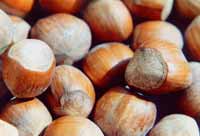 The Tonda Gentile seedlings are an old Italian variety.
The Tonda Gentile seedlings are an old Italian variety.
This hazelnut blooms and starts blooming mid-late, it is medium lush. The fruit is medium-sized, round, peels from the membrane 90 -100%, the kernel fulfills about 44-47% of the fruit, is of good fruitfulness, medium lush.
Ripening time: Mid-August
Rootstock: Turkish filbert
Seedlings of HAZELNUT – ISTRIA LONG:
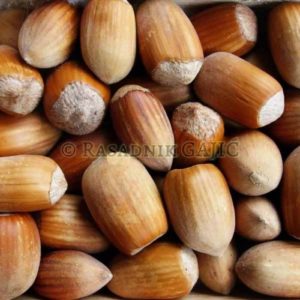 The Istria Long seedlings are an old variety of hazelnuts. This variety blooms and begins vegetation mid-early, medium lush to lush, with bent branches. The fruit is large and oblong, difficult to peel, the kernel fulfills about 43% of the fruit, very fruitful.
The Istria Long seedlings are an old variety of hazelnuts. This variety blooms and begins vegetation mid-early, medium lush to lush, with bent branches. The fruit is large and oblong, difficult to peel, the kernel fulfills about 43% of the fruit, very fruitful.
Ripening time: Mid-August
Rootstock: Turkish filbert
Seedlings of HAZELNUT - ROMAN:
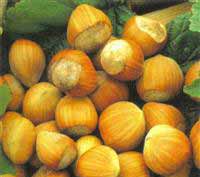 The Roman seedlings are an old Italian variety. It blooms and begins vegetation mid-late, is medium lush. The fruit is medium-sized, round, very fruitful.
The Roman seedlings are an old Italian variety. It blooms and begins vegetation mid-late, is medium lush. The fruit is medium-sized, round, very fruitful.
Ripening time: Mid-August
Rootstock: Turkish filbert
Seedlings of HAZELNUT - LUDOLF:
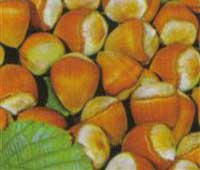 The tree is medium lush to lush. It blooms mid-early and ripens rather late. The fruit is large and round - belly-shaped. It is regularly and abundantly fruitful and an excellent variety for table consumption.
The tree is medium lush to lush. It blooms mid-early and ripens rather late. The fruit is large and round - belly-shaped. It is regularly and abundantly fruitful and an excellent variety for table consumption.
Ripening time: Mid-August
Rootstock: Turkish filbert
Seedlings of HAZELNUT – HALL’S GIANT:
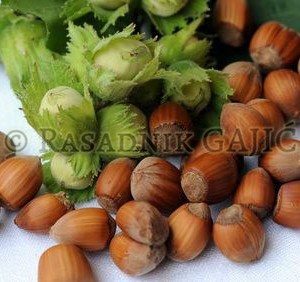 The Hall’s Giant seedlings are originally from Germany.
The Hall’s Giant seedlings are originally from Germany.
The tree is lush and very fruitful and tall. Cosford and other Spanish varieties are good pollinators for this type. The fruit is very large, round-conical in shape and slightly flattened, weighing about 3.6 g.
Ripening time: End of August – Beginning of September.
Rootstock: Turkish filbert
Seedlings of HAZELNUT - TONDA GENTILE DELLE LANGHE:
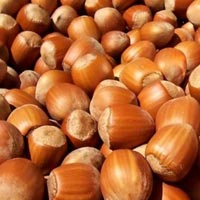 The Tonda Gentile delle Langhe are originally from Italy.
The Tonda Gentile delle Langhe are originally from Italy.
The fruits are rounded with a pointed tip, there are 2-3 in the cluster and they are small, weighing on average about 2.5 g. The fruit coat is as large as the fruit, so the fruits fall out easily, the shell is thin but hard. The bush is medium lush. It is a frutiful variety of hazelnuts. The kernel fulfills about 58%. It needs a pollinator, mostly Coutard, Hall’s Giant and Negret.
Ripening time: End of August
Rootstock: Turkish filbert and its own offshoot
Seedlings of HAZELNUT - TONDA DI GIFFONI:
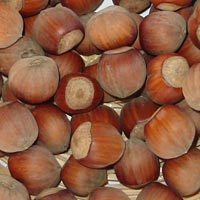 The Tonda di Giffoni seedlings are originally from Italy, Sicily.
The Tonda di Giffoni seedlings are originally from Italy, Sicily.
The tree is medium developed and not lush. It is characterized by good fruitfulness and excellent fruit quality. Its good pollinators are Barcelona, Round white and other. The fruit is round in shape, medium-sized, weighing about 2.5 g, with an average of 2-3 in the cluster. The round coat is longer than the fruit, but when ripe, the fruit easily falls out of it. The shell is medium thin with maroon stripes. The kernel fulfills about 46%. It is sensitive to late spring frosts.
Ripening time: End of August
Rootstock: Turkish filbert and its own offshoot
Seedlings of HAZELNUT - ENNIS:
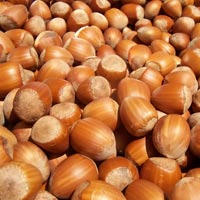 The Ennis seedlings are originally from the US. It is a newer and a high quality variety.
The Ennis seedlings are originally from the US. It is a newer and a high quality variety.
It has beautiful, very large fruits (about 4.7g) round-shaped to slightly elongated, bright and striped shell. The fruit coat is moderately developed and the fruits fall out easily when shaking, so it is recommended for mass cultivation in plantations. It is not sensitive to low temperatures. Good and regular fruitfulness. The kernel fulfills about 49%. This is the largest variety of hazelnut.
Good pollinators are: Hall’s Giant, Contorta, Purpurea maxima. It blooms late.
Ripening time: Mid-September
Rootstock: Turkish filbert
